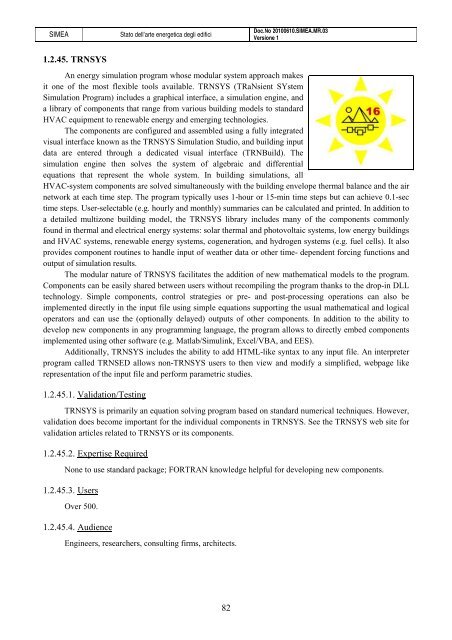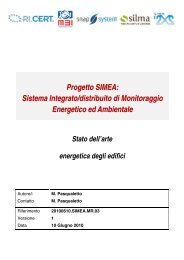Progetto SIMEA - Automatica - Università degli Studi di Padova
Progetto SIMEA - Automatica - Università degli Studi di Padova
Progetto SIMEA - Automatica - Università degli Studi di Padova
Create successful ePaper yourself
Turn your PDF publications into a flip-book with our unique Google optimized e-Paper software.
<strong>SIMEA</strong> Stato dell’arte energetica <strong>degli</strong> e<strong>di</strong>fici<br />
1.2.45. TRNSYS<br />
82<br />
Doc.No 20100610.<strong>SIMEA</strong>.MR.03<br />
Versione 1<br />
An energy simulation program whose modular system approach makes<br />
it one of the most flexible tools available. TRNSYS (TRaNsient SYstem<br />
Simulation Program) includes a graphical interface, a simulation engine, and<br />
a library of components that range from various buil<strong>di</strong>ng models to standard<br />
HVAC equipment to renewable energy and emerging technologies.<br />
The components are configured and assembled using a fully integrated<br />
visual interface known as the TRNSYS Simulation <strong>Stu<strong>di</strong></strong>o, and buil<strong>di</strong>ng input<br />
data are entered through a de<strong>di</strong>cated visual interface (TRNBuild). The<br />
simulation engine then solves the system of algebraic and <strong>di</strong>fferential<br />
equations that represent the whole system. In buil<strong>di</strong>ng simulations, all<br />
HVAC-system components are solved simultaneously with the buil<strong>di</strong>ng envelope thermal balance and the air<br />
network at each time step. The program typically uses 1-hour or 15-min time steps but can achieve 0.1-sec<br />
time steps. User-selectable (e.g. hourly and monthly) summaries can be calculated and printed. In ad<strong>di</strong>tion to<br />
a detailed multizone buil<strong>di</strong>ng model, the TRNSYS library includes many of the components commonly<br />
found in thermal and electrical energy systems: solar thermal and photovoltaic systems, low energy buil<strong>di</strong>ngs<br />
and HVAC systems, renewable energy systems, cogeneration, and hydrogen systems (e.g. fuel cells). It also<br />
provides component routines to handle input of weather data or other time- dependent forcing functions and<br />
output of simulation results.<br />
The modular nature of TRNSYS facilitates the ad<strong>di</strong>tion of new mathematical models to the program.<br />
Components can be easily shared between users without recompiling the program thanks to the drop-in DLL<br />
technology. Simple components, control strategies or pre- and post-processing operations can also be<br />
implemented <strong>di</strong>rectly in the input file using simple equations supporting the usual mathematical and logical<br />
operators and can use the (optionally delayed) outputs of other components. In ad<strong>di</strong>tion to the ability to<br />
develop new components in any programming language, the program allows to <strong>di</strong>rectly embed components<br />
implemented using other software (e.g. Matlab/Simulink, Excel/VBA, and EES).<br />
Ad<strong>di</strong>tionally, TRNSYS includes the ability to add HTML-like syntax to any input file. An interpreter<br />
program called TRNSED allows non-TRNSYS users to then view and mo<strong>di</strong>fy a simplified, webpage like<br />
representation of the input file and perform parametric stu<strong>di</strong>es.<br />
1.2.45.1. Validation/Testing<br />
TRNSYS is primarily an equation solving program based on standard numerical techniques. However,<br />
validation does become important for the in<strong>di</strong>vidual components in TRNSYS. See the TRNSYS web site for<br />
validation articles related to TRNSYS or its components.<br />
1.2.45.2. Expertise Required<br />
None to use standard package; FORTRAN knowledge helpful for developing new components.<br />
1.2.45.3. Users<br />
Over 500.<br />
1.2.45.4. Au<strong>di</strong>ence<br />
Engineers, researchers, consulting firms, architects.
















